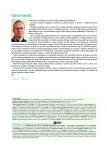Management of detection of tubal patency. A new available method performed in gynecologic practice – hysterosalpingo-foam sonography
Authors:
Jana Daňková Kučerová 1; Petr Kovář 2; Dagmar Smetanová 3; Martin Hynek 3; Tomáš Adamus 4
Authors place of work:
Gynprenatal s. r. o., Havířov, vedoucí lékař MUDr. Petr Kovář
1; Katedra chirurgických oborů (gynekologie) LF OU, Ostrava, vedoucí katedry MUDr. Petr Vávra, Ph. D.
2; Gennet s. r. o, Centrum lékařské genetiky a reprodukční medicíny, Praha
3; Katedra biomedicínských oborů LF OU, Ostrava, vedoucí katedry doc. RNDr. Kristian Šafarčík, Ph. D.
4
Published in the journal:
Prakt Gyn 2014; 18(4): 242-245
Category:
Gynekologie a porodnictví
Summary
Introduction:
Exclusion of tubal obstruction belongs to the first examinations absolved by every subfertile couple. There are several methods available, each having its merits and drawbacks.
Aim:
We are familiarizing medical public with a new accessible method confirming the patency of tubes which can be carried out in a gynecologic practice. We make comparison between laparoscopic, hydrolaparoscopic, hysterosalpingographic, kymo-insufflation and hysterosalpingo-sonographic examination. Based on literature abroad we are presenting sorting criterions for choosing suitable method and possibility of individual approach to the each patient.
Methods and results:
We are presenting current experience from two practices (Gennet s.r.o. Praha, Gynprenatal s.r.o. Havířov), where hysterosalpingo-foam sonography performed in practice is part of the diagnostic algorithm of the tubal factor of sterility. We are summarizing experience in medical literature.
Conlusion:
Hysterosalpingo-foam sonography seems to be simple, efficient, unexpensive, accesible method with minimal impact of the patient at the same time is comparatively as reliable as more invasive methods for the diagnosis of the patency of tubes and it can be a screening test.
Key words:
hysterosalpingo-contrast sonography – hysterosalpingo-foam sonography – hysterosalpingography – hysteroscopy – laparoscopy – office hysteroscopy – tubal patency
Zdroje
1. Zegers-Hochschild F, Adamson GD, Mouzon J et al. The International Committee for Monitoring Assisted Reproductive Technology (ICMART) and the World Health Organization (WHO) Revised Glossary of Art Terminology 2009; 24(11): 2683–2687.
2. Duron S., Slama R., Ducot B et al. Cumulative incidence rate of medical consultation for fecundity problems – analysis of a prevalent cohort using competing risks. Hum Reprod 2013; 28(10): 2872–2879.
3. Collins JA, Burrows EA, Wilan AR. The prognosis for life birth among untreated infertile couples. Fertil Steril 1995; 64(1): 22–28.
4. Snick HK, Snick TS, Evers JL et al. The spontaneous pregnancy prognosis in untreated subfertile couples: the Walcheren primary care study. Hum Reprod 1997; 12(7):1582–1588.
5. Steinkeler JA,Woodfield CA, Lazarus E et al. Female infertility: a systematic approach to radiologic imaging and diagnosis. Radiographics 2009; 29(5): 1353–1370.
6. Saunders RD, Shwayder JM, Nakajima ST. Current methods of tubal patency assessment. Fertil Steril 2011; 95(7): 2171–2179.
7. Lim ChP, Hasafa Z, Bhattacharya S et al. Should a hysterosalpingogram be a first-line investigation to diagnose female tubal subfertility in the modern subfertility workup? Hum Reprod 2011; 26(5): 967–971.
8. Malik A, Jain S, Rizvi M et al Chlamydia trachomatis infection in women with secondary infertility. Fertil Steril 2009; 91(1): 91–95.
9. Jansen FW, Kapiteyn K, Trimbos-Kemper T et al. Complications of laparoscopy: a prospective multicentre observational study. Br J Obstet Gynaecol 1997; 104(5): 595–600.
10. Coppus SF, Opmeer BC, Logan S et al. The predictive value of medical history taking and Chlamydia IgG ELISA antibody testing (CAT) in the selection of subfertile women for diagnostic laparoscopy: a clinical prediction model approach. Hum Reprod 2007; 22(5): 1353–1358.
11. Sobek A Jr, Hammadeh M, Vodicka J et al. Ultrasonographically guided transvaginal hydroaparoscopy. Acta Obstet Gynecol Scand 2008; 87(10): 1077–1080.
12. Ezedinma NA, Phelps JY. Transvaginal hydrolaparoscopy. JSLS 2012; 16(3): 461–465.
13. Abergel A, Rubod C, Merlot B et al. Transvaginal hydrolaparoscopy for infertility investigation: a retrospective study, about 262 patients. Gynecol Obstet Fertil 2014; 42(2): 97–103.
14. Nielsen DT, Rasmussen F, Justesen P. A comparative study of hysterosalpingography and endoscopy/laparotomy in infertile patients. Eur J Radiol 1987; 7(4): 260–262
15. Broeze KA, Opmeer BC, Van Geloven N et al. Are patient characteristics associated with the accuracy of hysterosalpingography in diagnosing tubal pathology? An individual patient data meta-analysis. Hum Reprod 2010; 17(3): 297–300.
16. Řežábek, K. Léčba neplodnosti. 4th ed. Grada Publishing: Praha 2008. ISBN 978–80–247–2103–3.
17. Kucera E, Andrasova V, Novak J et al. Kymo-insufflation and hydrotubation in treatment of tubal occlusions. Ceska gynekol 1967; 32(8): 599–602.
18. Deichert U, Schlief R, Van de Sandt M et al. Transvaginal hysterosalpingo-contrast-sonography (HyCoSy) compared with conventional tubal diagnostics. Hum Reprod 1989; 4(4): 418–424.
19. Reis MM, Soares SR, Cancado ML et al. Hysterosalpingocontrast sonography (HyCoSy) with SH U 454 (Echovist) for the assessment of tubal patency. Hum Reprod 1998; 13(11): 3049–3052.
20. Exalto N, Stappers C, van Raamsdonk LA et al. Gel instillation sonohysterography: first experience with a new technique. Fertil Steril 2007; 87(1): 152–155.
21. Emanuel MH, van Vliet M, Weber M et al. First experiences with hysterosalpingo-foam sonography (HyFoSy) for office tubal patency testing. Hum Reprod 2012; 27(1): 114–117.
22. Papaioannou S, Bourdrez P, Varma R et al. Tubal evaluation in the investigation of subfertility: a structured comparison of tests. BJOG 2004; 111(12): 1313–1321.
23. Savelli L, Pollastri P, Guerrini M et al. Tolerability, side effects, and complications of hysterosalpingocontrast sonography (HyCoSy). Fertil Steril 2009; 92(4): 1481–1486.
24. Kovář P, Kučerová J. Negynekologické kontraindikace „office” hysteroskopie prováděné v ambulanci. Prakt Gyn 2013; 17(1): 68–73.
Štítky
Dětská gynekologie Gynekologie a porodnictví Reprodukční medicínaČlánek vyšel v časopise
Praktická gynekologie

2014 Číslo 4
- Primární prevence osteoporózy v kostce
- Horní limit denní dávky vitaminu D: Jaké množství je ještě bezpečné?
- Isoprinosin je bezpečný a účinný v léčbě pacientů s akutní respirační virovou infekcí
- Dlouhodobé užívání dienogestu v terapii endometriózy
- Postupné vysazování inhibitorů protonové pumpy
Nejčtenější v tomto čísle
- Dienogest – spolehlivý progestin s unikátní přidanou hodnotou
- Klasifikace děložní myomatózy a její diagnostika ve vztahu k reprodukčním dysfunkcím
- Management zjištění průchodnosti vejcovodů. Nově dostupná ambulantní metoda – hysterosalpingo-foam sonografie (HyFoSy)
- Perioperační péče na gynekologickém oddělení
